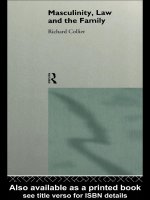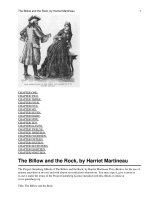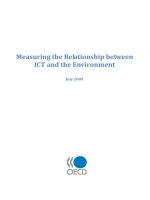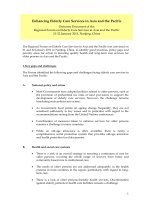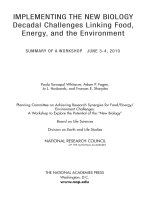Church and the Barbarians ppt
Bạn đang xem bản rút gọn của tài liệu. Xem và tải ngay bản đầy đủ của tài liệu tại đây (543.38 KB, 116 trang )
CHAPTER I
CHAPTER II
CHAPTER III
CHAPTER IV
CHAPTER V
CHAPTER VI
CHAPTER VII
CHAPTER VIII
CHAPTER IX
CHAPTER X
CHAPTER XI
CHAPTER XII
CHAPTER XIII
CHAPTER XIV
CHAPTER XV
CHAPTER XVI
CHAPTER XVII
CHAPTER I
CHAPTER II
CHAPTER III
CHAPTER IV
CHAPTER V
CHAPTER VI
CHAPTER VII
CHAPTER VIII
Chapters
CHAPTER IX
CHAPTER X
CHAPTER XI
CHAPTER XII
1
CHAPTER XIII
CHAPTER XIV
CHAPTER XV
CHAPTER XVI
CHAPTER XVII
Church and the Barbarians, by William Holden
Hutton
Project Gutenberg's The Church and the Barbarians, by William Holden Hutton This eBook is for the use of
anyone anywhere at no cost and with almost no restrictions whatsoever. You may copy it, give it away or
re-use it under the terms of the Project Gutenberg License included with this eBook or online at
www.gutenberg.org
Title: The Church and the Barbarians Being an Outline of the History of the Church from A.D. 461 to A.D.
1003
Author: William Holden Hutton
Release Date: August 21, 2007 [EBook #22366]
Language: English
Character set encoding: ISO-8859-1
*** START OF THIS PROJECT GUTENBERG EBOOK THE CHURCH AND THE BARBARIANS ***
Produced by Al Haines
THE CHURCH AND THE BARBARIANS
BEING AN OUTLINE OF THE HISTORY OF THE CHURCH FROM A.D. 461 TO A.D. 1003
BY THE REV.
WILLIAM HOLDEN HUTTON, B.D.
FELLOW AND TUTOR OF S. JOHN BAPTIST COLLEGE, OXFORD
EXAMINING CHAPLAIN TO THE BISHOP OF ROCHESTER
RIVINGTONS
34 KING STREET, COVENT GARDEN
LONDON
1906
Church and the Barbarians, by William Holden Hutton 2
[Transcriber's note: Page numbers in this book are indicated by numbers enclosed in curly braces, e.g. {99}.
They have been located where page breaks occurred in the original book, in accordance with Project
Gutenberg's FAQ-V-99. For the book's Index, a page number has been placed only at the start of that section.]
[Transcriber's note: Footnotes have been renumbered sequentially and moved to the end of their respective
chapters. The book's Index has a number of references to footnotes, e.g. the "96 n." entry under "Assyrians."
In such cases, check the referenced page to see which footnote(s) are relevant.]
[Transcriber's note: The original book had side-notes in its pages' left or right margin areas. Some of these
sidenotes were at or near the beginning of a paragraph, and in this e-text, are placed to precede their host
paragraph. Some were placed elsewhere alongside a paragraph, in relation to what the sidenote referred to
inside the paragraph. These have been placed into the paragraph near where they were in the original book.
All sidenotes have been enclosed in square brackets, and preceded with "Sidenote:".]
EDITORIAL NOTE
While there is a general agreement among the writers as to principles, the greatest freedom as to treatment is
allowed to writers in this series. The volumes, for example, will not be of the same length. Volume II., which
deals with the formative period of the Church, is, not unnaturally, longer in proportion than the others. To
Volume VI., which deals with the Reformation, will be allotted a similar extension. The authors, again, use
their own discretion in such matters as footnotes and lists of authorities. But the aim of the series, which each
writer sets before him, is to tell, clearly and accurately, the story of the Church, as a divine institution with a
continuous life.
W. H. HUTTON
PREFACE
It has seemed to me impossible to deal with the long period covered by this volume as briefly as the scheme
of the series required without leaving out a great many events and concentrating attention chiefly upon a few
central facts and a few important personages. I think that the main results of the development may thus be
seen, though there is much which is here omitted that would have been included had the book been written on
other lines.
Some pages find place here which originally appeared in The Guardian and The Treasury, and a few lines
which once formed part of an article in The Church Quarterly Review. My thanks are due for the courtesy of
the Editors. I have reprinted some passages from my Church of the Sixth Century, a book which is now out of
print and not likely to be reissued.
I have to thank the Rev. L. Pullan for help from his wide knowledge, and Mr. L. Strachan, of Heidelberg, of
whose accuracy and learning I have had long experience, for reading the proofs and making the index.
W. H. H.
S. JOHN'S COLLEGE, OXFORD, Septuagesima, 1906.
CONTENTS
Church and the Barbarians, by William Holden Hutton 3
CHAPTER I
PAGE THE CHURCH AND ITS PROSPECTS IN THE FIFTH CENTURY . . . . 1
CHAPTER I 4
CHAPTER II
THE EMPIRE AND THE EASTERN CHURCH, 461-628 . . . . . . . . 6
CHAPTER II 5
CHAPTER III
THE CHURCH IN ITALY, 461-590 . . . . . . . . . . . . . . . 29
CHAPTER III 6
CHAPTER IV
CHRISTIANITY IN GAUL FROM THE SIXTH TO THE EIGHTH CENTURY 41
CHAPTER IV 7
CHAPTER V
THE PONTIFICATE OF GREGORY THE GREAT . . . . . . . . . . . 60
CHAPTER V 8
CHAPTER VI
CONTROVERSY AND THE CATHOLICISM OF SPAIN . . . . . . . . . 72
CHAPTER VI 9
CHAPTER VII
THE CHURCH AND THE MONOTHELITE CONTROVERSY . . . . . . . . 83
CHAPTER VII 10
CHAPTER VIII
THE CHURCH IN ASIA . . . . . . . . . . . . . . . . . . . . 93
CHAPTER VIII 11
CHAPTER IX
THE CHURCH IN AFRICA . . . . . . . . . . . . . . . . . . 103
CHAPTER IX 12
CHAPTER X
THE CHURCH IN THE WESTERN ISLES . . . . . . . . . . . . . 113
CHAPTER X 13
CHAPTER XI
THE CONVERSION OF SLAVS AND NORTHMEN . . . . . . . . . . . 123
CHAPTER XI 14
CHAPTER XII
PROGRESS OF THE CHURCH IN GERMANY . . . . . . . . . . . . 134
CHAPTER XII 15
CHAPTER XIII
THE POPES AND THE REVIVAL OF THE EMPIRE . . . . . . . . . 143
CHAPTER XIII 16
CHAPTER XIV
THE ICONOCLASTIC CONTROVERSY . . . . . . . . . . . . . . . 155
CHAPTER XIV 17
CHAPTER XV
LEARNING AND MONASTICISM . . . . . . . . . . . . . . . . . 166
CHAPTER XV 18
CHAPTER XVI
SACRAMENTS AND LITURGIES . . . . . . . . . . . . . . . . . 176
CHAPTER XVI 19
CHAPTER XVII
THE END OF THE DARK AGE . . . . . . . . . . . . . . . . . . 191
APPENDIX I LIST OF EMPERORS AND POPES . . . . . . . . . . . . . . . . 205
APPENDIX II A SHORT BIBLIOGRAPHY . . . . . . . . . . . . . . . . . . . 209
INDEX . . . . . . . . . . . . . . . . . . . . . . . . . . . 211
{1}
THE CHURCH AND THE BARBARIANS
CHAPTER XVII 20
CHAPTER I
THE CHURCH AND ITS PROSPECTS IN THE FIFTH CENTURY
[Sidenote: The task of the Church]
The year 461 saw the great organisation which had ruled and united Europe for so long trembling into decay.
The history of the Empire in relation to Christianity is indeed a remarkable one. The imperial religion had
been the necessary and deadly foe of the religion of Jesus Christ; it had fought and had been conquered.
Gradually the Empire itself with all its institutions and laws had been transformed, at least outwardly, into a
Christian power. Questions of Christian theology had become questions of imperial politics. A Roman of the
second century would have wondered indeed at the transformation which had come over the world he knew: it
seemed as if the kingdoms of the earth had become the kingdoms of the Lord and of His Christ. But also it
seemed that the new wine had burst the old bottles. The boundaries of the Roman world had been outstepped:
nations had come in from the East and from the West. The {2} system which had been supreme was not
elastic: the new ideas, Christian and barbarian alike, pressed upon it till it gave way and collapsed. And so it
came about that if Christianity had conquered the old world, it had still to conquer the new.
[Sidenote: The decaying Empire.]
Now before the Church in the fifth century there were set several powers, interests, duties, with which she was
called upon to deal; and her dealing with them was the work of the next five centuries. They were, the
Empire, Christian, but obsolescent; the new nations, still heathen, which were struggling for territory within
the bounds of the Empire, and for sway over the imperial institutions; the distant tribes untouched by the
message of Christ; and the growth, within the Church itself, of new and great organisations, which were
destined in great measure to guide and direct her work. Politics, theology, organisation, missions, had all their
share in the work of the Church from 461 to 1003. In each we shall find her influence: to harmonise them we
must find a principle which runs through her relation to them all.
[Sidenote: The need of unity.]
The central idea of the period with which we are to deal is unity. Up till the fifth century, till the Council of
Chalcedon (451) completed the primary definition of the orthodox Christian faith in the person of the Lord
Jesus Christ, Christians were striving for conversion, organisation, definition. All these aims still remained,
but in less prominence. The Church's order was completed, the Church's creed was practically fixed, and the
dominant nations in Europe had owned the name of Christ. There remained a new and severe test. Would the
{3} Church win the new barbarian conquerors as she had won the old imperial power? There was to be a great
epoch of missionary energy. But of the firm solidity of the Church there could be no doubt. Heresies had torn
from her side tribes and even nations who had once belonged to her fold. But still unity was triumphant in
idea; and it was into the Catholic unity of the visible Church that the new nations were to be invited to enter.
S. Augustine's grand idea of the City of God had really triumphed, before the fifth century was half passed,
over the heathen conceptions of political rule. The Church, in spite of the tendency to separate already visible
in East and West, was truly one; and that unity was represented also in the Christian Empire. "At the end of
the fifth century the only Christian countries outside the limits of the Empire were Ireland and Armenia, and
Armenia, maintaining a precarious existence beside the great Persian monarchy of the Sassanid kings, had
been for a long time virtually dependent on the Roman power." [1] Politically, while tyrants rise and fall, and
barbarian hosts, the continuance of the Wandering of the Nations, sweep across the stage, we are struck above
all by the significant fact which Mr. Freeman (Western Europe in the Fifth Century) knew so well how to
make emphatic: "The wonderful thing is how often the Empire came together again. What strikes us at every
step in the tangled history of these times is the wonderful life which the Roman name and the Roman Power
still kept when it was thus attacked on every side from without and torn in pieces in every quarter from
within." And the reason for this indubitably was that the {4} Empire had now another organisation to support
CHAPTER I 21
it, based on the same idea of central unity. One Church stood beside one Empire, and became year by year
even more certain, more perfect, as well as more strong. In the West the papal power rose as the imperial
decayed, and before long came near to replacing it. In the East, where the name and tradition of old Rome was
always preserved in the imperial government, the Church remained in that immemorial steadfastness to the
orthodox faith which was a bond of unity such as no other idea could possibly supply. In the educational work
which the emperor had to undertake in regard to the tribes which one by one accepted their sway, the
Christian Church was their greatest support. In East as well as West, the bishops, saints, and missionaries
were the true leaders of the nations into the unity of the Empire as well as the unity of the Church. [Sidenote:
The Church's conquest of barbarism.] The idea of Christian unity saved the Empire and taught the nations.
The idea of Christian unity was the force which conquered barbarism and made the barbarians children of the
Catholic Church and fellow-citizens with the inheritors of the Roman traditions.
If the dominant idea of the long period with which this book is to deal is the unity of the Church, seen through
the struggles to preserve, to teach, or to attain it, the most important facts are those which belong to the
conversion, to Christ and to the full faith of the Catholic Church, of races new to the Western world. The
gradual extinction in Italy of the Goths, the conversion of the Franks, of the English, of many races on distant
barbarian borderlands of civilisation, the acceptance of Catholicism by the Lombards and {5} the Western
Goths, do not complete the historical tale, though they are a large part of it: there was the falling back in
Africa and for a long time in Europe of the settlements of the Cross before the armies of the Crescent. There
were also two other important features of this long-extended age, to which writers have given the name of
dark. There was the survival of ancient learning, which lived on through the flood of barbarian immigration
into the lands which had been its old home, yet was very largely eclipsed by the predominance of theological
interests in literature. And there was the growth of a strong ecclesiastical power, based upon an orthodox faith
(though not without hesitations and lapses), and gradually winning a formidable political dominion. That
power was the Roman Papacy.
[1] Bryce, Holy Roman Empire, p. 13, ed. 1904.
{6}
CHAPTER I 22
CHAPTER II
THE EMPIRE AND THE EASTERN CHURCH
(461-628)
When the death of Leo the Great in 461 removed from the world of religious progress a saintly and dominant
figure whose words were listened to in East and West as were those of no other man of his day, the interest of
Church history is seen to turn decisively to the East.
[Sidenote: Character of the Greek Church.]
The story of Eastern Christendom is unique. There is the fascinating tale of the union of Greek metaphysics
and Christian theology, and its results, so fertile, so vigorous, so intensely interesting as logical processes, so
critical as problems of thought. For the historian there is a story of almost unmatched attraction; the story of
how a people was kept together in power, in decay, in failure, in persecution, by the unifying force of a Creed
and a Church. And there is the extraordinary missionary development traceable all through the history of
Eastern Christianity: the wonderful Nestorian missions, the activity of the evangelists, imperial and
hierarchical, of the sixth century, the conversion of Russia, the preludes to the remarkable achievements in
modern times of orthodox missions in the Far East.
Throughout the whole of the long period indeed {7} which begins with the death of Leo and ends with that of
Silvester II., though the Latin Church was growing in power and in missionary success, it was probably the
Christianity of the East which was the most secure and the most prominent. Something of its work may well
be told at the beginning of our task.
[Sidenote: The Monophysite controversy.]
The last years of the fifth century were in the main occupied in the East by the dying down of a controversy
which had rent the Church. The Eutychian heresy, condemned at Chalcedon, gave birth to the Monophysite
party, which spread widely over the East. Attempts were soon made to bridge over the gulf by taking from the
decisions of Chalcedon all that definitely repudiated the Monophysite opinions. [Sidenote: The Henotikon.] In
482 the patriarch Acacius of Constantinople, under the orders probably of the Emperor Zeno (474-91), drew
up the Henotikon, an endeavour to secure the peace of the Church by abandoning the definitions of the Fourth
General Council. No longer was "one and the same Christ, Son, Lord, only-begotten, acknowledged in two
natures, without fusion, without change, without division, without separation." But it is impossible to ignore a
controversy which has been a cause of wide divergence. Men will not be silent, or forget, when they are told.
Statesmanlike was, no doubt, the policy which sought for unity by ignoring differences; and peace was to
some extent secured in the East so long as Zeno and his successor Anastasius (491-518) reigned. But at Rome
it was not accepted. Such a document, which implicitly repudiated the language of Leo the Great, which the
Fourth General Council had adopted, could {8} never be accepted by the whole Church; and those in the East
who were theologians and philosophers rather than statesmen saw that the question once raised must be finally
settled in the dogmatic decisions of the Church. Had the Lord two Natures, the Divine and Human, or but
one? The reality of the Lord's Humanity as well as of His Divinity was a truth which, at whatever cost of
division and separation, it was essential that the Church should proclaim and cherish.
In Constantinople, a city always keen to debate theology in the streets, the divergence was plainly manifest;
and a document which was "subtle to escape subtleties" was not likely to be satisfactory to the subtlest of
controversialists. The Henotikon was accepted at Antioch, Jerusalem, and Alexandria, but it was rejected by
Rome and by the real sense of Constantinople. In Alexandria the question was only laid for a time, and when a
bishop who had been elected was refused recognition by Acacius the Patriarch of Constantinople and Peter
"the Stammerer," who accepted the Henotikon, preferred to his place, a reference to Rome led to a peremptory
CHAPTER II 23
letter from Pope Simplicius, to which Acacius paid no heed whatever. Felix II. (483-92), after an ineffectual
embassy, actually declared Acacius excommunicate and deposed. The monastery of the Akoimetai at
Constantinople ("sleepless ones," who kept up perpetual intercession) threw itself strongly on to the side of
the advocates of Chalcedon. Acacius, then excommunicated by Rome because he would not excommunicate
the Monophysite patriarch of Alexandria, retorted by striking out the name of Felix from the diptychs of the
Church.
{9}
[Sidenote: Schism between East and West.]
It was the first formal beginning of the schism which, temporarily, and again and again, healed, was
ultimately to separate East and West; and it was due, as so many misfortunes of the Church have been, to the
inevitable divergence between those who thought of theology first as statesmen and those who thought first as
inquirers after the truth. The schism spread more widely. In Syria Monophysitism joined Nestorianism in the
confusion of thought: in Egypt the Coptic Church arose which repudiated Chalcedon: Abyssinia and Southern
India were to follow. Arianism had in the East practically died away; Nestorianism was powerful only in
far-away lands, but Monophysitism was for a great part of the sixth century strong in the present, and close to
the centre of Church life. The sixth century began, as the fifth had ended, in strife from which there seemed no
outway. Nationalism, and the rival claims of Rome and Constantinople, complicated the issues.
Under Anastasius, the convinced opponent of the Council of Chalcedon and himself to all intents a
Monophysite in opinion, some slight negotiations were begun with Rome, while the streets of Constantinople
ran with blood poured out by the hot advocates of theological dogma. In 515 legates from Pope Hormisdas
visited Constantinople; in 516 the emperor sent envoys to Rome; in 517 Hormisdas replied, not only insisting
on the condemnation of those who had opposed Chalcedon, but also claiming from the Caesar the obedience
of a spiritual son; and in that same year Anastasius, "most sweet-tempered of emperors," died, rejecting the
papal demands.
{10}
The accession of Justin I. (518-27) was a triumph for the orthodox faith, to which the people of
Constantinople had firmly held. The patriarch, John the Cappadocian, declared his adherence to the Fourth
Council: the name of Pope Leo was put on the diptychs together with that of S. Cyril; and synod after synod
acclaimed the orthodox faith. Negotiations for reunion with the West were immediately opened. The patriarch
and the emperor wrote to Pope Hormisdas, and there wrote also a theologian more learned than the patriarch,
the Emperor's nephew, Justinian. "As soon," he wrote, "as the Emperor had received by the will of God the
princely fillet, he gave the bishops to understand that the peace of the Church must be restored. This had
already in a great degree been accomplished." But the pope's opinion must be taken with regard to the
condemnation of Acacius, who was responsible for the Henotikon, and was the real cause of the severance
between the churches. [Sidenote: Reunion, 519.] The steps towards reunion may be traced in the
correspondence between Hormisdas and Justinian. It was finally achieved on the 27th of March, 519. The
patriarch of Constantinople declared that he held the Churches of the old and the new Rome to be one; and
with that regard he accepted the four Councils and condemned the heretics, including Acacius.
The Church of Alexandria did not accept the reunion; and Severus, patriarch of Antioch, was deposed for his
heresy. There was indeed a considerable party all over the East which remained Monophysite; and this party it
was the first aim of Justinian (527-65), when he became emperor, to convince or to subdue. He was the {11}
nephew of Justin, and he was already trained in the work of government; but he seemed to be even more
zealous as a theologian than as a lawyer or administrator. The problem of Monophysitism fascinated him.
[Sidenote: The Emperor Justinian.] From the first, he applied himself seriously to the study of the question in
all its bearings. Night after night, says Procopius, he would study in his library the writings of the Fathers and
CHAPTER II 24
the Holy Scriptures themselves, with some learned monks or prelates with whom he might discuss the
problems which arose from their perusal. He had all a lawyer's passion for definition, and all a theologian's
delight in truth. And as year by year he mastered the intricate arguments which had surged round the decisions
of the Councils, he came to consider that a rapprochement was not impossible between the Orthodox Church
and those many Eastern monks and prelates who still hesitated over a repudiation which might mean heresy or
schism. And from the first it was his aim to unite not by arms but by arguments. The incessant and wearisome
theological discussions which are among the most prominent features of his reign, are a clearly intended part
of a policy which was to reunite Christendom and consolidate the definition of the Faith by a thorough
investigation of controverted matters. Justinian first thought out vexed questions for himself, and then
endeavoured to make others think them out.
From 527, in the East, Church history may be said to start on new lines. The Catholic definition was
completed and the imperial power was definitely committed to it. We may now look at the Orthodox Church
as one, united against outside error.
{12}
A period of critical interest in the history of Europe is that to which belongs the difficult and complicated
Church history of the East from the accession of the Emperor Justinian to the death of S. Methodius.
The period naturally divides itself into three parts the first, from 527 to 628, dealing with the Church at the
height of its authority, up to the overthrow of the Persian power; the second to 725, the period up to the
beginning of the iconoclastic controversy; and the third up to its close and the death of S. Methodius in 847.
With the first we will deal in the present chapter.
[Sidenote: Church and State in the East.]
But throughout the whole three centuries, from 527 to 847, the essential character of the Church's life in the
east is the same. In the East the Church was regarded more decisively than in the West as the complement of
the State. Constantine had taught men to look for the officials of the Church side by side with those of the
civil power. At Constantinople was the centre of an official Christianity, which recognised the powers that be
as ordained of God in a way which was never found at Rome. At Rome the bishops came to be political
leaders, to plot against governments, to found a political power of their own. At Constantinople the patriarchs,
recognised as such by the Emperor and Senate of the New Rome, sought not to intrude themselves into a
sphere outside their religious calling, but developed their claims, in their own sphere, side by side with those
of the State; and their example was followed in the Churches which began to look to Constantinople for
guidance. There was a necessary consequence of this. {13} [Sidenote: Nationalism of the Churches.] It was
that when the nationalities of the East, in Egypt, Syria, Armenia, or even in Mesopotamia began to resent
the rule of the Empire, and struggled to express a patriotism of their own, they sought to express it also on the
ecclesiastical side, in revolt from the Church which ruled as a complement to the civil power. Heresy came to
be a sort of patriotism in religion. And while there was this of evil, it was not evil that each new barbarian
nation, as it accepted the faith, sought to set up beside its own sovereign its patriarch also. "Imperium," they
said, "sine patriarcha non staret," an adage which James I. of England inverted when he said, "No bishop, no
king." Though the Bulgarians agreed with the Church of Constantinople in dogmas, they would not submit to
its jurisdiction. The principle of national Churches, independent of any earthly supreme head, but united in the
same faith and baptism, was established by the history of the East. Gradually the Church of Constantinople,
by the growth of new Christian states, and by the defections of nations that had become heretical, became
practically isolated, long before the infidels hedged in the boundaries of the Empire and hounded the imperial
power to its death. Within the boundaries the Church continued to walk hand-in-hand with the State. Together
they acted within and without. Within, they upheld the Orthodox Faith; without, they gave Cyprus its religious
independence, Illyricum a new ecclesiastical organisation, the Sinaitic peninsula an autonomous hierarchy.
More and more the history of these centuries shows us the Greek Church as the Eastern Empire in its religious
CHAPTER II 25



